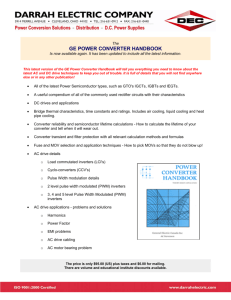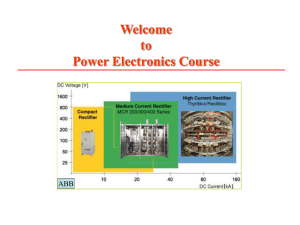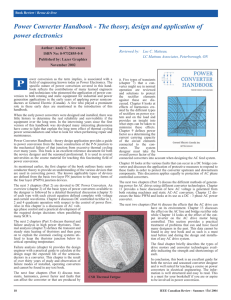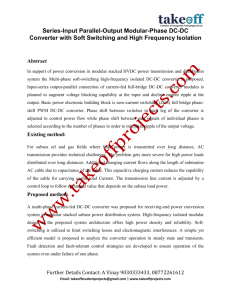Conversion Experience, Los Angeles Lawyer Magazine, November
advertisement
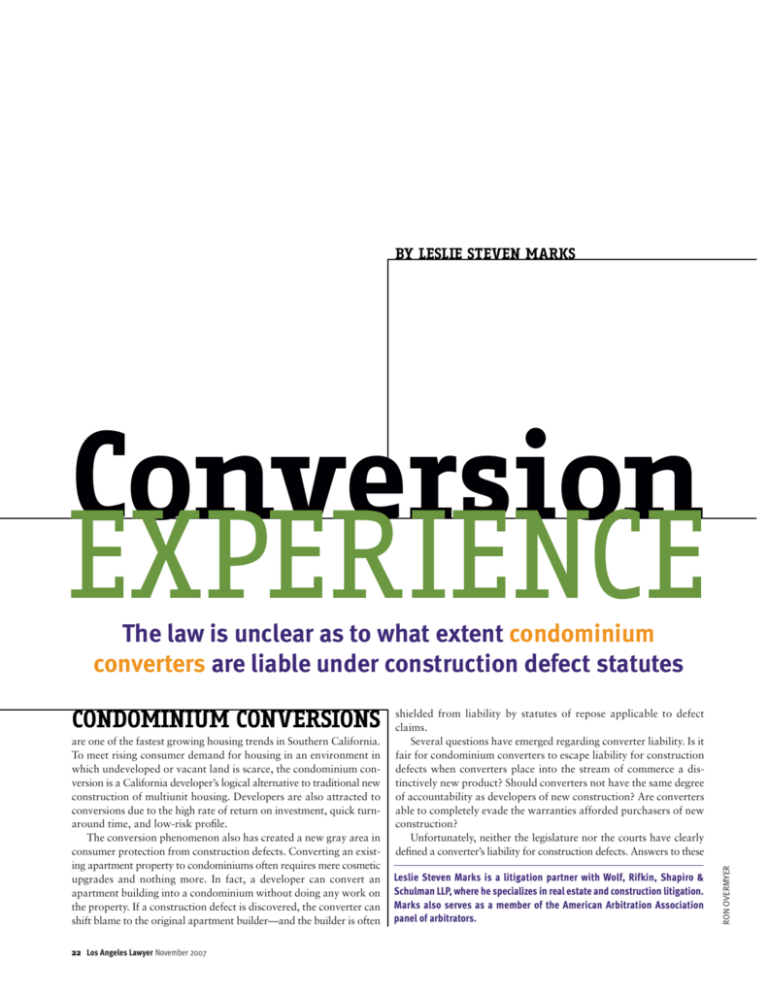
BY LESLIE STEVEN MARKS Conversion EXPERIENCE The law is unclear as to what extent condominium converters are liable under construction defect statutes are one of the fastest growing housing trends in Southern California. To meet rising consumer demand for housing in an environment in which undeveloped or vacant land is scarce, the condominium conversion is a California developer’s logical alternative to traditional new construction of multiunit housing. Developers are also attracted to conversions due to the high rate of return on investment, quick turnaround time, and low-risk profile. The conversion phenomenon also has created a new gray area in consumer protection from construction defects. Converting an existing apartment property to condominiums often requires mere cosmetic upgrades and nothing more. In fact, a developer can convert an apartment building into a condominium without doing any work on the property. If a construction defect is discovered, the converter can shift blame to the original apartment builder—and the builder is often 22 Los Angeles Lawyer November 2007 shielded from liability by statutes of repose applicable to defect claims. Several questions have emerged regarding converter liability. Is it fair for condominium converters to escape liability for construction defects when converters place into the stream of commerce a distinctively new product? Should converters not have the same degree of accountability as developers of new construction? Are converters able to completely evade the warranties afforded purchasers of new construction? Unfortunately, neither the legislature nor the courts have clearly defined a converter’s liability for construction defects. Answers to these Leslie Steven Marks is a litigation partner with Wolf, Rifkin, Shapiro & Schulman LLP, where he specializes in real estate and construction litigation. Marks also serves as a member of the American Arbitration Association panel of arbitrators. RON OVERMYER CONDOMINIUM CONVERSIONS and other perplexing questions may depend upon such factors as: 1) the amount of work that is actually done to the property, 2) specific county or city conversion requirements, and 3) the terms of the sales documents. A condominium conversion involves the transformation of existing rental property, most often an apartment building, into individual condominium units for sale to the public. The term “conversion” is defined in the Government Code as “a change of a residential dwelling…to a condominium, cooperative, or similar form of ownership.”1 The conversion process is governed by the Subdivision Map Act,2 which regulates the design, improvement, and sale of subdivisions and authorizes conditions for approval of subdivision maps. Condominium converters also must comply with the Davis-Stirling Common Interest Development Act,3 which establishes a uniform set of laws applicable to common interest developments. In addition, the sale of five or more condominiums requires a public report from the Department of Real Estate (DRE) pursuant to the Subdivided Lands Act.4 Finally, local governments are vested with considerable control over the design and improvement of land subdivision in California. Like virtually all civil litigation claims, construction defect actions must be brought within a specific time period mandated by statute. Different statutes of repose apply depending on whether the defects in question are considered “patent”—those that are apparent by reasonable inspection—or “latent”—those that do not present themselves until after the completion of construction. Code of Civil Procedure Section 337.1 applies to actions for patent construction defects and limits the filing of suit to a four-year period after substantial completion of the construction.5 Code of Civil Procedure Section 337.15, in contrast, provides for a 10-year statute of repose commencing from the time of substantial completion of construction for lawsuits arising from latent construction defects.6 Both Sections 337.1 and 337.15 apply to actions brought to recover damages from any person performing or furnishing the design, specifications, surveying, planning, supervision, observation of construction, or construction of an improvement to real property. This description of who may be sued presumably encompasses a condominium converter— but recent legislation makes the issue problematic.7 The statutory framework for construction defect litigation, including the statutes of repose of Sections 337.1 and 337.15, was completely overhauled in 2002 with the passage of Senate Bill 800, codified in Civil Code Sections 896 et seq. This law applies only to residential units for which the purchase agreement with the buyer was signed by the seller on or after January 1, 2003.8 Interestingly, this new law specifically excludes condominium conversions,9 even though condominium converters appear to fall squarely within the definition of a “builder” otherwise governed by the legislation.10 The law also fails to define what constitutes a condominium conversion, leaving open the possibility that substantial modifications to an existing structure may transform an old structure into a new residential unit within the meaning of this legislative scheme. Absent instructive case law on the issue and given the explicit exclusion of condominium conversions from the legislation, the statutes of repose set forth in Code of Civil Procedure Sections 337.1 and 337.15 likely apply. Indeed, Civil Code Section 896 specifically notes that it does not apply to condominium conversions and “does not supersede any other statutory or common law.” vise.11 Condominium converters are no different. The converter is held to a standard of care in the conversion process and a breach of this standard, causing damage, is actionable. In Orange Grove Terrace Owners Association v. Bryant Properties, Inc.,12 the California Court of Appeal considered the viability of an action for negligence by a homeowner’s association against the converter of the structure. The association, composed of 29 units, sued the converter on several theories, including negligence, for damages caused by faulty repairs made in the course of converting previously existing apartments into condominiums. The converter argued that since the repairs to the apartments were substantially completed before the association was organized and before it took control of the common areas, the association had no standing to sue for damages. The court rejected this argument, concluding that the timing of the association’s organization was a matter wholly within the control of the converter. According to the court, the converter could readily foresee that the association— which was obligated by the covenants and conditions promulgated by the converter to maintain and repair the common areas—would be damaged by an injury to the common areas caused by the converter’s negligence in undertaking repairs in the course of the condominium conversion.13 The Orange Grove court deemed it appropriate that: [I]f the defendants undertook to repair roofs, and in doing so negligently determined that patching, rather than replacement would suffice, the jury could reasonably determine that the roof repairs were negligently performed. Similarly, if the defendants negligently used copper pipe in repairing the common area galvanized piping, and thereby proximately caused damage to the galvanized piping, necessitating additional repair or replacement in the common areas, the defendants’ conduct would support an award of damages for negligently performed plumbing repairs.14 Converters undertaking repairs to a structure are therefore held to the standard of care applicable to a developer of newly constructed condominiums. Whether a converter has met that standard of care is a question of fact for the jury to decide. But what if the converter makes no physical improvements to the structure? At the very least, Civil Code Section 1134(a) obligates the converter to deliver to a prospective purchaser a written statement listing all substantial defects or malfunctions in the major systems of the property, or provide a written statement disclaiming knowledge of any substantial defects or malfunctions.15 The disclaimer may be delivered only after the converter conducts a reasonable inspection of the property and does not find a substantial defect or malfunction.16 If the converter is negligent in discharging this duty by either failing to adequately disclose defects in the property or by failing to conduct a reasonable inspection to support the disclaimer exemption, the converter may be responsible for damages caused by the later discovered construction defect. This code section is not designed to abridge or limit any other disclosure obligation created by law to avoid fraud, deceit, or misrepresentation in the transaction.17 Local county or municipal codes may impose upon the converter an affirmative obligation to bring the converted property in conformance with various building codes. Thus, a converter may be negligent per se if the converter violates these local county or municipal ordinances. Negligence and Negligence Per Se Strict Liability and Implied Warranty In the absence of clear authority making converters liable for construction defects, several alternative legal theories could make converters liable. One legal theory has two parts: negligence and negligence per se. Developers and contractors are liable for their own acts and omissions and the acts and omissions of those they hire or super- Strict liability and breach of implied warranty are two additional theories of recovery against a builder for construction deficiencies. Strict liability differs from negligence in that breach of duty need not be proven to establish liability. Instead, a plaintiff must only establish that a defective item was mass-produced and that the defect proxi- 24 Los Angeles Lawyer November 2007 mately caused damages.18 This theory of recovery was extended to mass producers of housing units.19 Implied warranty concepts—such as the warranty of fitness for a particular use and purpose, quality, and merchantability—have been applied to the construction and sale of residential property. In 1974, the California Supreme Court extended the doctrine of a builder’s and, arguably, the converter therefore should have the same status as a manufacturer and thus be held strictly liable in tort. As with strict liability, thus far the courts have refused to extend the theory of implied warranty to a condominium converter. However, the appellate court in East Hilton did suggest the possibility that even though Pollard extended implied warranty only to sellers of new con- implied warranty regarding defective construction to the sellers of new construction. In Pollard v. Saxe & Yolles Development Company,20 the court ruled that builders and sellers of new construction should be held to what is impliedly represented—namely, that the completed structure was designed and constructed in a reasonably workmanlike manner. California courts have yet to find a condominium converter liable for preexisting construction defects in a converted building under the doctrines of strict liability or implied warranty. At least one court refused to impose strict liability or breach of implied warranty on a seller that purchased a newly constructed building from its original builder but took no part in the construction of the structure. In East Hilton Drive Homeowners’ Association v. Western Real Estate Exchange, Inc.,21 the original builder of eight condominiums lost his investment to a bank foreclosure. The condominiums were purchased from the bank four years later by the appellant and, after repair and rehabilitation, the units were sold to the respondents. The structure then sustained water damage. The court held that, as the successor in interest to the original developer, the appellant was not liable under the doctrines of strict liability and implied warranty regarding defective construction.22 The court concluded that only the sellers of new construction could be held accountable under these theories of liability.23 However, an argument can be fashioned that the doctrine of strict liability should apply to a converter for defective refurbishment of a particular system that was the direct cause of property damage. In Peterson v. Superior Court of Riverside County,24 the court considered the merits of an action for strict liability against a hotel owner for injuries sustained by the plaintiff in a hotel bathtub. The court rejected the application of strict products liability to a residential landlord or a hotel proprietor who was not part of the manufacturing process.25 The court likened the two to a seller of used machinery who is not strictly liable in tort.26 However, the court carved out an exception to this general rule. When the seller rebuilds or reconditions the used product, the seller assumes the role of a manufacturer and will be held strictly liable in tort.27 By analogy, a condominium converter is nothing more than a seller of a reconditioned product— struction, if a home could be considered new construction when acquired, the doctrine of implied warranty would apply: [I]f [the homes] could be considered new construction when appellant acquired them, then the Pollard case would impose an implied warranty on that sale. But appellant who had no part in building or financing the building of these homes, cannot be considered a seller of new construction whether it occupied the homes or not.28 The East Hilton court proceeded to discuss the rationale of the Pollard decision: Pollard extended the warranty because builders and sellers of new construction are in a better position than buyers of new construction to know of defects. There is no reason to extend this warranty to appellant simply because the homes had lain vacant for a number of years.29 Under the Pollard rationale, a converter may be considered a seller of new construction if the converter engages in the refurbishment of the structure. Moreover, the converter is in a better position than the buyer to know of possible defects. It may simply be a matter of time before the courts extend the doctrine of implied warranty to a seller of converted units. Fraud and Other Theories It is well established that a seller of real property is obligated to disclose all material facts affecting the value or desirability of the property if these facts are known or accessible only to the seller, and the seller knows that these facts are not known to, or within the reach of, the diligent attention and observation of the buyer.30 The failure of a seller to fulfill this duty of disclosure constitutes actual fraud31 and, under these circumstances, the seller is liable for any damage suffered by the buyer.32 An “as-is” provision typically used in real estate sales documents does not relieve the seller of liability for the seller’s affirmative misrepresentations or material omissions of fact.33 The condominium converter, as a seller of real property, is under the same duty of disclosure—particularly since the converter, and not the buyer, is in a position to know material factors such as the age of the building, the nature and extent of any refurbishment, and the Los Angeles Lawyer November 2007 25 current condition of the structure. In addition to the duty of all sellers to disclose material facts to prospective buyers, distinct disclosure obligations apply to the condominium converter. Under most circumstances, for example, the DRE requires a converter to submit a DRE Form 639 along with an application for a public report. DRE Form 639 requires the aspiring converter to disclose such information as the age of the property and the history of improvements to the units and to the major components of the common areas, including the dates of all renovations. The form also asks the converter to submit inspection reports from qualified engineers or contractors on major systems of the structure such as the foundation, plumbing, structural, electrical, roofing, and mechanical components. Should the converter elect not to submit one or more reports, the DRE may include in the public report a special note warning the consumer of the seriousness of this lack of information. Finally, the converter is required by Civil Code Section 1134 to deliver to the prospective buyer a written statement. It must either list all substantial defects or malfunctions in the major systems of the units and common areas, or disclaim knowledge of these types of defects or malfunctions. Two other possible theories of liability may apply to a condominium converter. As a marketing tool or otherwise, a converter may choose to expressly warrant the condition of the condominium. An express warranty is an affirmation of fact made by the seller to the buyer regarding the items sold.34 Express warranties are made in the sales documents—typically the purchase agreement and/or escrow instructions. A converter who breaches express warranties contained in the purchase documents is strictly liable for related damages.35 Another theory is breach of fiduciary duty. One of the initial steps in the condominium conversion process is the creation of an association, typically a nonprofit mutual benefit corporation. The association is governed by its board of directors and its officers. The duties and obligations of these association representatives are governed by, among other things, a set of covenants, conditions, and restrictions (CC&Rs) that are submitted to the DRE for approval and later recorded with the appropriate county recorder’s office. The converter or the converter’s agent often comprises the first board of directors for the association. As an association director, the converter owes a fiduciary duty to the association and its members that requires the converter to manage association affairs honestly and in good faith.36 Once the homeowner association is established as an independent legal entity and a majority of units have been sold, the converter typically transfers all the converter’s rights and interests in the project to a newly elected board. While serving as a board member, the converter is required to, among other things, properly determine an operating budget and also fund and maintain an adequate reserve account. Both functions are critical for the maintenance of common areas and to ensure the availability of funds for capital improvements. A leading California case in the area of fiduciary obligations owed by a director to an association is Raven’s Cove Townhomes, Inc. v. Knuppe Development Company, Inc.37 In Raven’s Cove, an association of condominium owners brought suit against the project developer for defects in common area landscaping and the exterior walls of individual units. The defendants, former association directors, were the developers of the complex and in control of the association in its early planning stages. The developer-directors neither established a reserve or operating fund as required by the association documents nor adequately maintained the premises, which resulted in defects to the common areas. The association alleged that the developer-directors breached their fiduciary duty by failing to properly determine operating costs and fund a maintenance reserve account. The court of appeal concluded that the board owed a duty of undi26 Los Angeles Lawyer November 2007 vided loyalty when it considered matters such as maintenance and repair contracts and the creation of reserve and operating accounts. Further, the court held that it was improper for the directors to make decisions for the association that were beneficial to the directors’ interest at the expense of the association and its members.38 In an effort to increase profitability, a condominium converter could be tempted to manage the project in a manner that is under budget or under reserve, which would constitute a breach of a director’s fiduciary duty to act in good faith and without conflict of interest. Under these circumstances, an association with construction deficiencies would have a cause of action for breach of fiduciary duty against the converter. Insuring Condominium Converters The conversion craze also has created some concerns for the insurance industry. In general, underwriters view condominium conversions as a greater insurance risk than completely new construction, in part due to the age of converted structures and the mistaken perception of buyers that converted structures are either brand new or completely renovated. Nevertheless, insurance underwriters are issuing insurance policies on these projects. These policies either identify the converter as the named insured or are issued as an endorsement, through a contractor or subcontractor, that names the converter as an additional insured. The most common type of liability insurance39 available to the condominium converter is the Commercial General Liability Policy,40 which affords the converter indemnity and defense against claims for third-party bodily injury or property damage. This policy can be purchased in two forms: an “occurrence” policy or a “claims-made” policy. Most construction-risk CGL policies are purchased on an occurrence basis, which means that the policy applies to injury or damage sustained during the policy period, even though the policy may have expired. The occurrence policy is favored by converters because, theoretically, it offers prospective coverage through the expiration of applicable statutes of repose for construction defect claims. The second form of insurance coverage available to the converter, the “claims made” policy, limits coverage to claims made against the insured while the policy is in effect. This form of policy is less popular to the converter because, to achieve maximum risk protection, the converter is required to maintain the policy, sometimes at great cost, well after the units have been sold. A CGL policy issued to the converter—whether as a named insured or by virtue of a contractor’s endorsement—does not necessarily guarantee protection from the risk of construction defect damage claims. Standard CGL policies are replete with coverage exclusions that, depending upon the facts and circumstances surrounding the construction and the nature of the damage claimed, may eliminate the converter’s immunity from personal risk.41 Converters are well advised to take certain steps to lower their personal exposure and risk to construction defect claims and to maximize their underwriting profile:42 • Carefully select the project. Converters should avoid converting a structure that is old and in extreme disrepair unless they are prepared to 1) undertake a thorough investigation of the structure, including possible destructive testing, to determine the existence and the extent of any defects, and 2) thereafter implement significant repairs. • Require indemnity provisions from sellers. A converter should include an indemnity provision in the purchase agreement requiring the seller of the structure to indemnify and defend the converter for construction defect claims brought against the converter after the sale of the structure. • Ensure that the structure receives a thorough, professional inspection. A thorough, third-party professional inspection will assist converters in making their decision to purchase and convert a property. . ANY STATE . ANY NATION . ANY WHERE .ANY STATE . ANY NATION . ANYWHERE. ANY STATE . ANY NATION . WE SERVE ANYTHING, ANYWHERE STATEWIDE . NATIONWIDE . WORLDWIDE 1-800 PROCESS 1 800 process.com "If we don't serve it, you don't pay" ® U.S.A. Only SERVING A SINGLE PIECE OF PROCESS EVERY 2.2 MINUTES OF EVERY DAY, 365 DAYS A YEAR. A DIVISION OF GUARANTEED SUBPOENA SERVICE est. 1965 ANY STATE . ANY NATION . ANYWHERE. ANY STATE . ANY NATION . ANYWHERE . ANY STATE . ANY NATION . ANY WHERE. ANY STATE . ANY NATION . . ANY STATE . ANY NATION . ANYWHERE . ANY STATE . ANY NATION . ANYWHERE. . ANY STATE . ANY NATION . ANYWHERE. ANY STATE . ANY NATION . ANYWHERE A positive report from a construction professional will also enhance a converter’s chances of procuring the appropriate insurance for the project. • Disclose, disclose, disclose. Full disclosures should be made by converters not only to the DRE but also to unit purchasers. The disclosures should include the age of the property, inspections and reports undertaken by construction professionals, and an explanation of repairs and renovations to common areas and individual units. A condominium converter’s liability for construction defects will remain a legal quandary until the courts or the legislature define a condominium conversion as either new or old construction. In the meantime, converters will continue to seek protection from risk while trial courts decide, on an ad hoc basis, whether to apply traditional legal liability theories to a nontraditional creation. ■ 1 GOV’T CODE §65590(G)(l). Subdivision Map Act, G OV ’ T C ODE §§6641066499.37. 3 Davis-Stirling Common Interest Development Act, CIV. CODE §§1350 et seq. 4 Subdivided Lands Act, BUS. & PROF. CODE §§1100011200. 5 CODE CIV. PROC. §337.1. 6 CODE CIV. PROC. §337.15(a); see also CODE CIV. PROC §337.15(g) (defining substantial completion of an 2 improvement as being not later than the date of one of the following, whichever occurs first: 1) the date of final inspection by the applicable public agency, 2) the date of recordation of a valid notice of completion, 3) the date of use or occupation of the improvement, or 4) one year after termination or cessation of work on the improvement). 7 Code of Civil Procedure §337.15(a) adds the words “who develops real property” to the class of persons protected by the statute. 8 CIV. CODE §938. 9 CIV. CODE §896. 10 CIV. CODE §911(a). 11 Sabella v. Wisler, 59 Cal. 2d 21, 28 (1963). 12 Orange Grove Terrace Owners Ass’n v. Bryant Props., Inc., 176 Cal. App. 3d 1217 (1986). 13 Id. at 1223. 14 Id. at 1223-24. 15 “Major systems” are defined to include, among other things, the roof, walls, floors, heating, air conditioning, plumbing, and electrical systems. CIV. CODE §1134(c)(1). 16 CIV. CODE §1134(a). 17 CIV. CODE §1134(g). 18 Del Mar Beach Club Owners Ass’n v. Imperial Contracting Co., 123 Cal. App. 3d 898, 909-10 (1981). 19 Kriegler v. Eichler Homes, Inc., 269 Cal. App. 2d 224, 228-29 (1969). 20 Pollard v. Saxe & Yolles Dev. Co., 12 Cal. 3d 374, 380 (1974). 21 East Hilton Drive Homeowners’ Ass’n v. Western Real Estate Exch., Inc., 136 Cal. 3d 630 (1982). 22 Id. at 632-33. 23 Id. 24 Peterson v. Superior Court of Riverside County, 10 Cal. 4th 1185 (1995). 25 Id. at 1188-89. 26 Id. at 1200-01. 27 Id. 28 East Hilton, 136 Cal. App. 3d at 632. at 633. 30 Lingsch v. Savage, 213 Cal. App. 2d 729, 735-36 (1963). 31 CIV. CODE §1572(3); see also Lingsch, 213 Cal. App. 2d at 736. 32 CIV. CODE §1710. 33 Lingsch, 213 Cal. App. 2d at 740-41. 34 COM. CODE §2313(1)(a). 35 See, e.g., Bassin Oil Co. v. Bash-Ross Tool Co., 125 Cal. App. 2d 578 (1954). Thus liability can be imposed entirely independent of the question of negligence. 36 CORP. CODE §309. 37 Raven’s Cove Townhomes, Inc. v. Knuppe Dev. Co., Inc., 114 Cal. App. 3d 783 (1981). 38 Id. at 799. 39 Another type of insurance available for construction risk is the Architects and Engineers Professional Liability Policy, which covers the services of design professionals. This policy is commonly known as an errors and omissions policy. 40 In 1986, the name of the policy was changed from Comprehensive Commercial Liability Policy to Commercial General Liability Policy. 41 The standard CGL policy was initially created by the Insurance Services Office, Inc. (ISO), an independent service agency for the liability industry. The form has been revised several times since its creation in 1940. See SCOTT TURNER, INSURANCE COVERAGE OF CONSTRUCTION DEFECTS 10 (2d ed. 2007). The ISO forms contain certain relevant exclusions, including those commonly referred to as the work product, premises alienated, earth movement, and contractual liability exclusions. 42 See CONSTRUCTION INDUSTRY UPDATE, Jan. 2005 (steps suggested by the insurance industry). 29 Id. WHY PAY MORE FOR LAWYER’S LIABILITY INSURANCE? FILL OUT ONE APPLICATION AND YOU COULD SAVE UP TO 30% OFF YOUR CURRENT INSURANCE. WHY PAY MORE? Lawyer’s Liability Insurance is a necessary cost of doing business and you should not pay any more than you have to. GO DIRECTLY TO THE SOURCE First Indemnity is the DIRECT underwriter for State National and First Mercury Insurance Companies. This insurance is not available through your local broker. By cutting out the broker, you cut out the red tape and in many cases increase your coverage. ONE APPLICATION CAN SAVE YOU 10% - 30% By going directly to the source, you get the same great service, save money and generally increase your coverage. CALL TODAY! Call 800-982-1151 to find out how to you can save money and increase your coverage. READY TO GET A QUOTE? Go to www.firstindemnity.net and download an application. AUTOMATIC COVERAGE √ Vicarious Liability coverage’s √ Claims Made Coverage √ Personal Injury (broad Form) √ Aggregate Deductible √ Unlimited Extended Reporting Periods available √ Provisions for Death Disability and Retirement √ Defendants Reimbursement √ $10,000 Per Policy Period, No Deductible √ Prior Law Firm Coverage √ Rule 11 Sanctions $10,000 √ 50% Reduction of Deductible for the use of Mediation or Arbitration to resolve claim OPTIONAL COVERAGES • First Dollar Defense • Additional Limit for Claims Expense • Title Agency Coverage • Collection Agency Coverage FIRST INDEMNITY 1-800-982-1151 Insurance Services, Inc. IL 10 South Riverside Plaza Suite 1800 W Loop Center Chicago, IL 60606 1-800-982-1151 CA 1800 Century Park East Suite 600 Los Angeles, CA 90076 1-800-982-1151 NY 420 Lexington Ave. Suite 300 New York, NY 10170 1-800-982-1151 www.firstindeminty.net Fax: 617-426-7173 Fax: 617-426-6642 TX 5956 Sherry Lane Suite 1000 Dallas, TX 75225 1-800-982-1151 MA 41 West Street 5th Floor Boston, MA 02111 1-800-982-1151 FL 2202 N Westshore Blvd. Suite 200 Tampa, FL 33607 1-800-982-1151 *First Mercury Insurance Company Rated A- Excellent By AM Best and Company *State National Insurance Company Rated A Excellent By AM Best and Company *Licensed and Admitted in all 50 States. * CA License # 0C60203 28 Los Angeles Lawyer November 2007
